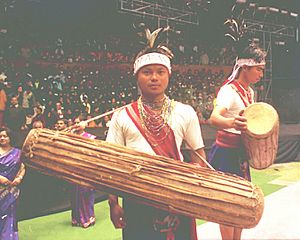Wangala facts for kids
Wangala is a special harvest festival, also known as the "Hundred Drums Festival." It is celebrated by the Garo tribe. The Garo people live in parts of India, including Meghalaya, Nagaland, and Assam. They also live in Greater Mymensingh in Bangladesh.
During this festival, the Garo people thank Misi Saljong, their sun god. They thank him for giving them a great harvest. Wangala is usually celebrated between September and December. Different villages choose different dates for their celebrations.
Contents
The Hundred Drums Festival: A Modern Celebration
The first big "Hundred Drums Wangala Festival" was held on December 6 and 7, 1976. It took place in Asanang, near Tura, India. Since then, this festival has been celebrated every year.
This event has become very popular. Dance groups from places like Bangladesh and Karbi Anglong now join in. There are even prizes for the best dance groups! The 100 Drums Festival is supported by the state government. It attracts many visitors from local areas, other parts of India, and even other countries each year.
How Wangala is Celebrated
Wangala is traditionally celebrated for two to three days. Sometimes it can even last up to a week! Usually, two or three villages celebrate together. In big cities, it might be celebrated for just one day. This helps keep the old traditions alive for younger generations.
Traditional Wangala Celebrations
You can find the most traditional Wangala celebrations in remote "Songsarek" villages. These are villages where people still follow old beliefs and worship ancient gods. Sadolpara in West Garo Hills is one such village.
The Big 100 Drums Festival
A larger, more public version of Wangala is the 100 Drums Festival. This event is held in Asanang, Meghalaya. Performers from all over Garo Hills come to this festival. Groups from places like Karbi Anglong, Tripura, and Bangladesh also join. These areas have many Garo people.
This big event lasts for three days. It includes many fun activities like sports, food stalls, and displays of art and culture. Students from Christian Girls' Higher Secondary School, Tura often represent Tura at this festival. They learn the Wangala dance as part of their school lessons.
Important Rituals and Dances
The first day of Wangala involves special rituals. These are called Rugala and Cha·chat So·a.
A priest, known as a "Kamal," performs these rituals. They take place inside the house of the Nokma. The Nokma is the village chieftain.
The main dance is called Dama Gogata. This dance happens on the last day of the celebration. Men and women dance with drums, flutes, and brass instruments. They wear colorful clothes and special feathered headgear. This dance is a famous part of Wangala.
Dressing Up for the Festival
During Wangala, everyone, young and old, wears their best clothes.
- Women wear colorful garments like Dakmanda or Daksari.
- Men wear Gando.
- Everyone wears feathered headgear called do'me.
They dance to music played on long, oval-shaped drums called Dama.
Other Performances
Many other performances happen during Wangala. These include:
- Katta Doka: This is like talking in a singing style, or traditional tribal rapping.
- Ajia
- Dani Doka: This involves singing to describe the Wangala festival.
- Chambil Mesaa: Also known as the Pomelo Dance.


